Lincoln Marker & The Crossing
Introduction
Text-to-speech Audio
On February 15, 1861, Abraham Lincoln, the 16th President of the United States stopped briefly on his way to Washington for his inauguration to eat at the original Sourbeck House and briefly speak to the townspeople. This marker was built from stones from the Lincoln family farm in Kentucky and placed near the spot where Lincoln spoke.
This railroad crossing was one of the first to be constructed in northeast Ohio, and it created the first railroad connection between Pittsburgh, Cleveland and Cincinnati. From the early 1850s through the First World War, Alliance’s railroad stations were both a gateway to the world and the world’s first glimpse of this bustling Ohio community. There are currently two stations still standing here: the mid-century brick structure nearest to the crossing served for passengers and freight service from 1953 until 2011, and further east is a modest, unstaffed, contemporary Amtrak stop which serves as the only passenger train stop between Pittsburgh and Cleveland.
Images
Lincoln Marker at the Crossing made from stones from the Lincoln farm in Kentucky
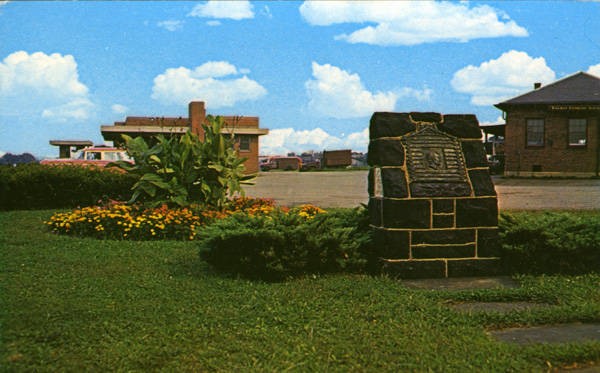
The Amtrak Station serving Alliance today. It opened in 2011. Two Pittsburgh-Chicago trains stop daily in the wee hours.
_(4).jpg)
Section of an 1885 Bird's Eye View of Alliance Drawing showing the area of the station, roundhouse, and The Crossing
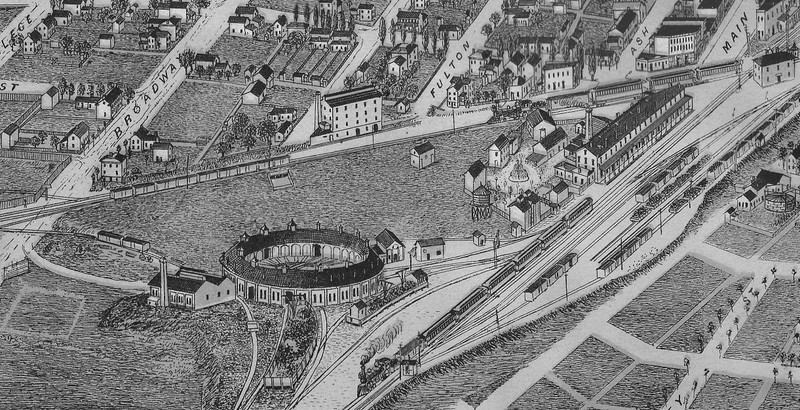
The original building at The Crossing in January 1852 as drawn by an Alliance Review illustrator in 1906. This building would be replaced in the summer with the first Alliance Station, serving both the Ohio & Pennsylvania and Cleveland & Pittsburgh railroads
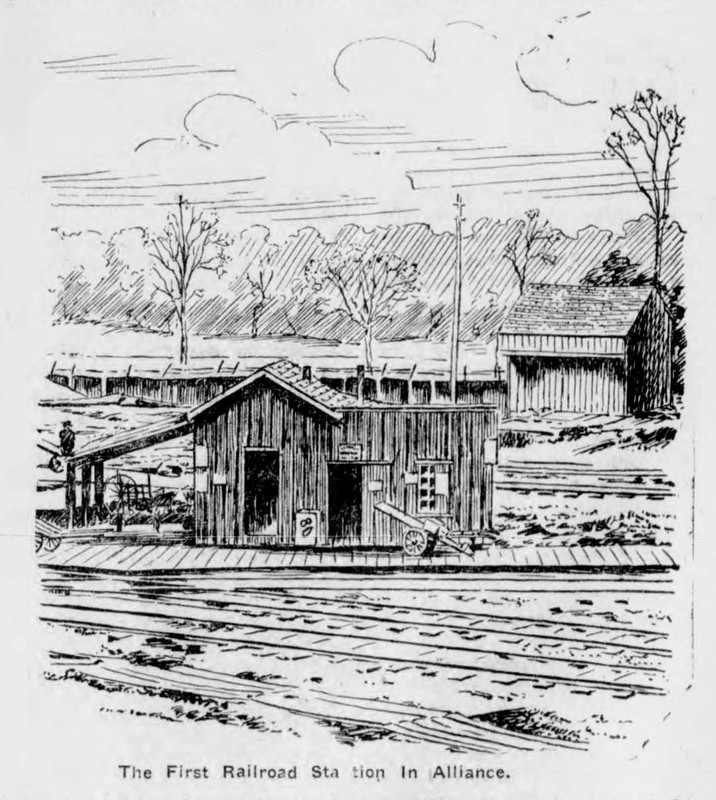
The Sourbeck House at the Alliance Union Depot, as it appeared in a lithograph created at its opening in 1866.
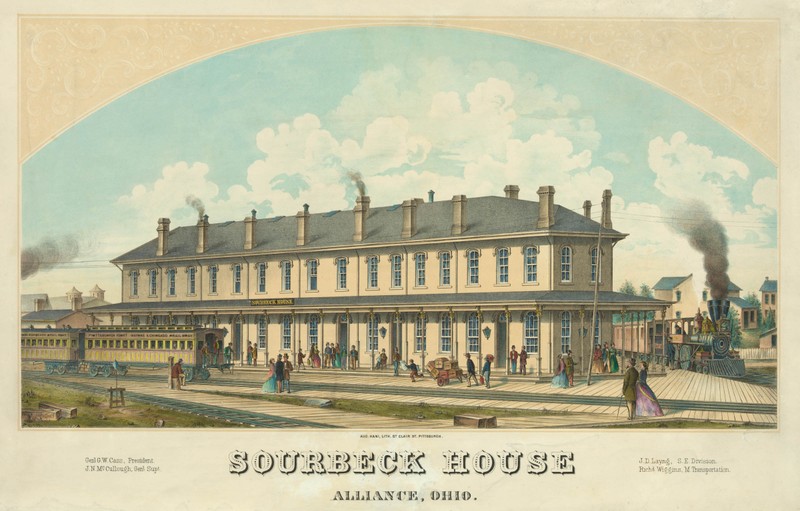
The original Alliance Station built on the northeastern corner of The Crossing in 1852
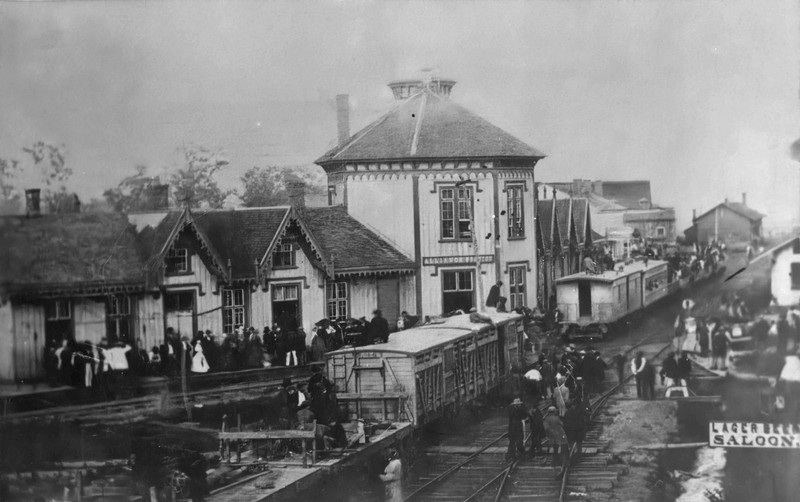
Aerial view of The Crossing and Downtown Alliance circa 1951
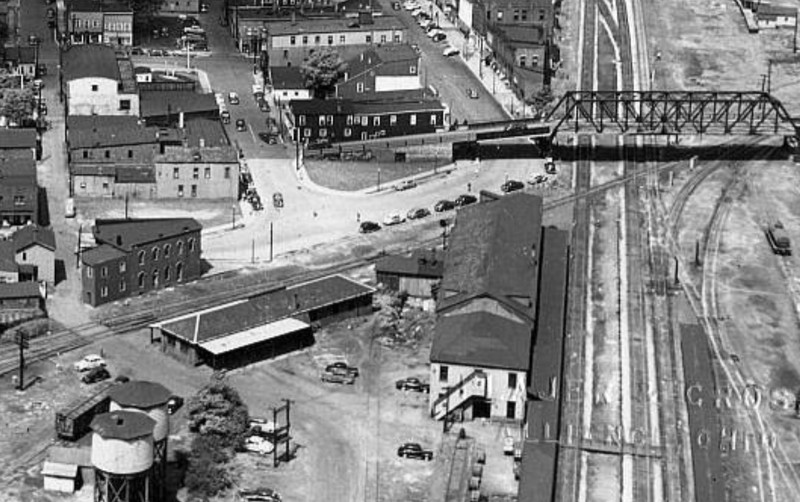
Presidential candidate Joe Biden spoke at the Amtrak Station on September 30, 2020. Protesters and supporters also came, thought were socially distanced across the street from The Crossing.

Alliance's Lincoln Memorial as it appeared in The Alliance Review in 1936.
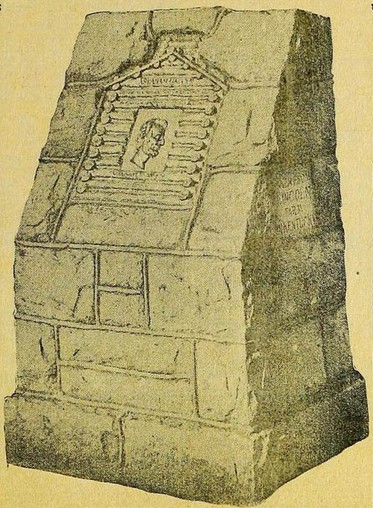
Alliance Pennsylvania Railroad Station, circa 1960s
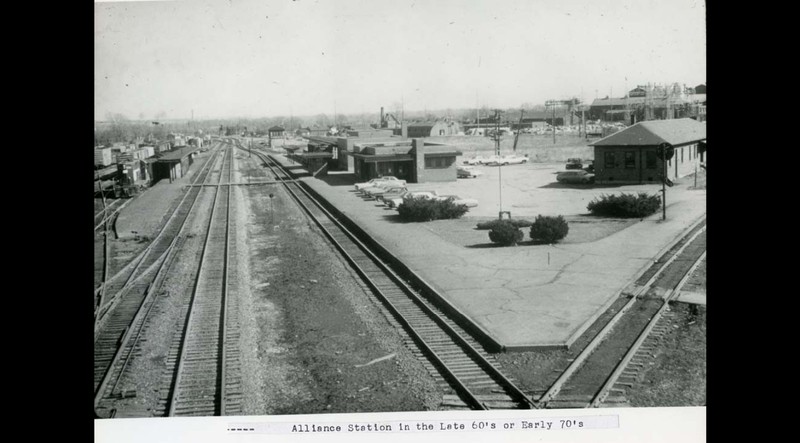
Backstory and Context
Text-to-speech Audio
In 1851, a substantial Ohio & Pennsylvania Rail Road - Alliance Station was constructed along with a water tower, wood storage, and a maintenance shop. The C&P had a smaller maintenance and resupply turnout about a half mile north of The Crossing, and for a time used the Shaefer Store at the square of the Village of Freedom as its first station.
The O&P union depot was a new kind of station for a new era of railroading on the north side of The Crossing. Because travel could last an entire day and longer, stations now provided food at “eating houses” in addition to inside waiting areas, ticketing, baggage and freight services. Because this was an important waypoint, the officers of the O&P sought to create a distinctive structure and felt they needed a special proprietor for its eating house. They brought Colonel Daniel Sourbeck and his wife Eliza to Alliance from New Brighton, Pennsylvania who had operated the Sourbeck House hotel and restaurant in that town for several years and had gained a favorable reputation in western Pennsylvania.
Alliance grew in the 1850s around the railroad depot. It was a rough and muddy town with modest frame buildings. By 1860, it had “about twenty stores, a weekly newspaper, one manufacturing establishment, etc. Population about 1,500,” according to Hawes State Gazette and Business Directory, which also noted its location at the junction of the C&P and the newly re-christened Pittsburgh, Fort Wayne & Chicago Rail Road (PFW&C), which had reorganized the O&P along with two western sister lines into one company which had completed its “main line” railroad into Chicago the previous year.
Perhaps the most memorable community event of the early years in Alliance occurred at the Union Depot on February 15, 1861 when Abraham Lincoln’s Inaugural Train pulled into the station shortly before 2:00 pm on a rainy afternoon which a Salem, Ohio reporter described as turning the town into a veritable “City of Mud.” Much of the trip had been arranged by PFW&C’s President George W. Cass to carry Lincoln between Illinois and Pittsburgh primarily on his railroad. The stop had been arranged by local professional photographer and Lincoln Committee chair Emmor Crew. A crowd of over a thousand people and the Haines Cornet Band assembled in the soaking rain to greet the President-elect. Lincoln and his party were served a sumptuous turkey dinner by Col. Sourbeck which one of the out of state reporters described “the best meal upon the trip.”
Alliance had a growing industry serving the agricultural business needs of the region, was serviced by two rail lines, and was being recognized as a crossroads of the Midwest. Local businessmen began planning for new ventures in the community to attract additional industries and people. The first step was bringing the division headquarters for the PFW&C to the depot grounds. It had been promised as a part of the consolidation in 1856, but did not become a reality until 1863 when the company, buoyed by the income driven by war production and transport, began building a roundhouse, additional repair shops and offices on land donated by Teeters, Levi Lamborn, and the Salem-based investors Simeon Jennings and Joseph J. Brooks
A tragic fire on September 23, 1863 however, destroyed the Union Depot. Plans were made to build a new depot. Teeters and Lamborn also plated 990 lots in 1865 to more than double the number of home in Alliance, and opened Alliance College as a community centerpiece on the hill above the downtown in 1868. At the end of the Civil War Alliance was ready to grow as were the railroads. On September 10th, 1866 the new depot was opened, and in honor of its proprietor, was affectionately and widely known simply as the Sourbeck House. Daniel and Eliza retired in 1882 and returned to Brighton, PA. Alliance’s Pennsylvania Railroad Union Depot continued to serve the community until 1953.
HIGHLIGHTS
A busy railroad station was the source of humorous, touching, and sad stories throughout the decades. Here are a few:
• Amos Ailes, a sturdy, stout railroad man, who would serve in the yards and lines around Alliance for almost forty years, was at the station as the famously tall Abrham Lincoln was returning to his railcar after lunch. Ailes approached the President-to-be and said, “Mr. Lincoln, I believe that I am as tall as you.' Mr. Lincoln, squaring his shoulders and looking at Mr. Alles replied. 'I could eat salt off the top of your hat'.
• A brighter spot reflecting community cohesion and determination was centered on the Union Depot during the First World War—the establishment of the Red Cross Canteen for traveling soldiers. During the nineteen months of the US involvement in the War almost 600 canteens had opened across the country. Planning did not begin until the summer of 1918, but the Pennsylvania Railroad donated the use of the old depot dining room to the Red Cross and the women’s groups of the Alliance community to provide food and a relaxing space for traveling soldiers passing through the station. Dozens of local groups planned a schedule for “woman-ing” the Canteen and it opened in the fall.
Individual and small groups of soldiers traveling on regularly scheduled trains, as well as local service men visiting home, could simple stop anytime throughout the day. Even more importantly, when troop trains of hundreds were on the way, the women were alerted and prepared to serve sandwiches, fruit, candy, donuts and coffee either in their station room or deliver directly to the soldiers on the trains. In the first month, The Review reported that 10,610 men were served on the trains and 222 in the station, and 732 dozen sandwiches, 619 dozen donuts, 50 bushels of fruit and 529 ½ gallons of coffee were served.
• A January 1905 Canton Morning News article noted that Alliance passenger station employees were planning to stop the new custom of “making the depot a place for meeting and public flirtation. Many young men and young women frequent the place in the early hours of the evening and their conduct is often obnoxious in nature and one of the railway police remarked Sunday evening that very slight further provocation would warrant him in making arrests.”
• Alliance has its own, homegrown “Lincoln Memorial” at The Crossing. Dedicated in October 1934, it is a small bronze plaque with “Honest Abe’s” profile mounted on stones, one of which came from the Lincoln farm in Kentucky. It stands under four feet tall and recognizes that long ago visit to a fresh, bustling Midwest crossroads. It was buried beneath shrubs for years, but in 2012 was made anew with fresh plantings tended by local gardeners over the past decade. Perhaps today, we can consider this place as another kind of gateway—a gateway to Alliance’s history.
Sources
Levi L. Lamborn, The History of Lexington Township (Alliance: Alliance Historical Society, 2018), pp. 106, 113, 149.
“Alliance House,” Ohio Repository, June 16, 1852.
“ ’Alliance’ from the Alliance Commercial,” Stark County Republican, April 4, 1864, Canton, Ohio.
John H. Cramer, “Lincoln in Ohio,” Ohio History Journal, April-June 1945, Ohio Historical Society.
Augustus Hani, lithographer, “Sourbeck House,” Library of Congress-Photo-Print-Drawing, Accessed November 18, 2018, https://www.loc.gov/item/2013645236/.
Stewart McKee, A Business Directory for the City of Alliance, (Alliance: Monitor Power Press, 1868), pp. 61-61.
Heald, Edward T., The Stark County Story, Volume I. (Canton, Ohio: The Stark County Historical Society, 1949) pp. 237-239.
Pages from Alliance History, As Printed in The Alliance Review, 1940-1941, Alliance: Alliance Historical Society, 1946, p. 34.
Rodman Public Library. “Alliance Canteen,” Alliance Memory. Accessed April 7, 2020. https://www.alliancememory.org/digital/collection/places/id/1371/rec/2
“Public to See New Depot,” The Alliance Review, February 22, 1953, Review Publishing, Alliance, Ohio, pp 1 & 3.
Alliance Historical Society, “Alliance’s Lincoln Memorial Today,” Facebook-Alliance Historical Society, Accessed April 7, 2020, https://www.facebook.com/alliancehistory/photos/a.204487362900998/2991363310880042/?type=3&theater
https://www.alliancememory.org/digital/collection/places/id/645/rec/2
https://en.wikipedia.org/wiki/Alliance_station#/media/File:Alliance_station_(March_2021)_(4).png
"Alliance, Ohio - 1885," Published by H. G. Howland, Cleveland, OH, Alliance Area Preservation Society Collection.
https://ohiomemory.org/digital/collection/p16007coll36/id/92101/rec/45
https://www.loc.gov/item/2013645236/
https://www.alliancememory.org/digital/collection/places/id/266/rec/4
https://www.alliancememory.org/digital/collection/places/id/625/rec/124
https://www.cantonrep.com/picture-gallery/news/2020/09/30/biden-whistle-stop-tour/3589018001/
"75 Years Ago Saturday, Abe Lincoln Spoke in Alliance," The Alliance Review, February 12, 1936
https://www.alliancememory.org/digital/collection/places/id/1752/rec/7
